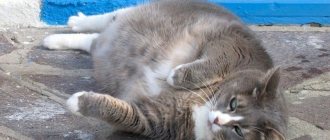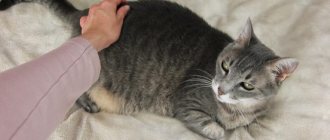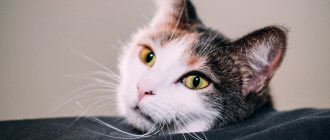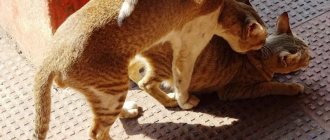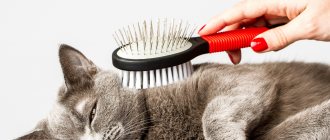The domestic cat is a placental mammal, like humans, so the principle of conception and pregnancy is similar. Cats are characterized by multiple births; one litter brings up to five to seven kittens. A healthy young cat can become pregnant and give birth up to three times a year, although this regimen is not recommended for many reasons. Finding out details about cat pregnancy is useful not only for professional and novice breeders, but also for simply pet owners.
How to prepare for childbirth
A healthy female can give birth up to 5 times a year, so owners have to be careful to avoid accidental mating.
The question of how to find out when a cat lambs arises after a mating that happened without the knowledge of the owner. The owner needs to show her to the veterinarian to determine the timing of the birth of the offspring. Gestation lasts 9 weeks, preparation of the body begins in 7-10 days. You can find out that an important moment is approaching if you carefully monitor how the cat behaves before giving birth, as its habits change. She becomes restless and tries to hide. A characteristic sign of preparation is nesting syndrome, which is manifested by attempts to arrange a bed in a hard-to-reach place.
Feeding before birth
2-3 days before giving birth, the cat’s appetite worsens, which is considered normal. It is recommended to feed your pet 5-6 times a day in small portions. Remove foods that cause constipation/diarrhea from the diet and give liquid foods: broths, milk. Change the water frequently.
How to arrange a place
The birthing area is prepared in advance so that the pet gets used to it and knows where she will give birth to kittens. Otherwise, she will arrange the bed herself, choosing a secluded place under the sofa, bathroom or in the closet. Then it will be difficult for the owner to help the cat during childbirth.
How to prepare a place for a cat to give birth:
- Find a warm corner away from drafts and noise, where strangers, children, and pets have no access.
- Prepare a spacious box for mother and offspring.
- Cover the bottom with oilcloth, put a mattress on top, then moisture-absorbing diapers (not scented).
- Place bowls for food and water nearby, and a tray with filler not far from the box.
What to prepare from medicines, materials, tools
It is recommended to collect the first aid kit and auxiliary items in advance and keep it next to the box.
To give birth to a cat you will need:
- surgical gloves;
- syringes;
- sharp scissors with rounded ends;
- diapers (soft cotton fabric);
- sterile thread (preferably catgut from a veterinary pharmacy);
- 6-7 pcs. clean cotton towels for drying kittens;
- cotton swabs, sticks;
- pipette;
- sterile syringe with a rubber tip;
- a jar of water for placentas;
- petrolatum;
- alcohol, veterinary antiseptic solution (or brilliant green, hydrogen peroxide, iodine, chlorhexidine);
- antibiotic ointment;
- warmer;
- milk formula for newborn kittens (if the cat refuses to feed).
The following medications will be needed: Oxytocin , Sulfocamphocaine , sodium gluconate. Application and dosage should be agreed with your veterinarian. It is recommended to arrange a consultation or call with him in advance so that he can help the cat give birth at home.
Signs of pregnancy in a pet
Noticing that your cat will soon become a mother is not always easy - animals will not tell us about their well-being. However, we can carefully observe our four-legged friend and identify changes. First of all, you need to understand whether the female and male had sexual intercourse. It only lasts a couple of seconds. This can be recognized by the cat’s behavior: it will move away from the cat or even show aggression, and also lick the genital area. Now we can talk about the signs of a cat’s pregnancy:
- The heat stops. A female can become pregnant not at any time, but only during estrus. It happens several times a year, which is accompanied by special symptoms. For example, a family favorite becomes too affectionate, rolls on the floor or rubs against the owner’s legs, and meows invitingly loudly. After conception, all this comes to naught: the pet seems to become indifferent, and the cat begins to irritate the cat. She hisses at him and doesn’t let him near her, since she’s no longer interested in mating.
- Behavior. At the beginning of pregnancy, the female often changes: she refuses food, shows excessive affection or aggression, looks lethargic, and may go to the toilet frequently. This is usually a short-term phenomenon and goes away in a few days. It's no wonder that many owners don't even have time to notice.
- The mammary glands change. The cat's nipples become brighter in color and swell by the third week. At this moment, the fur around them seems to move apart, exposing them.
Pregnant cats' nipples become more noticeable.
How to determine that your pet has been pregnant for a long time? Gradually, her weight will begin to increase, but for some it changes slightly. Almost all females become calmer, refuse active games, and prefer to sleep more. In the later stages, they often begin to search for a secluded place for childbirth.
Important! You should not try to palpate the fetus, as this can cause serious harm to the animal.
A visit to the veterinarian and a diagnosis is the most reliable way to know that your cat will soon have adorable kittens. At the clinic, the doctor will suggest doing an ultrasound or conducting a blood test to determine the level of the hormone relaxin.
Ultrasound diagnostics is the most reliable way to find out a cat’s gestational age and the number of fetuses.
False pregnancy
It also happens that a cat ovulates, but conception fails. Sometimes this ends in a false pregnancy. The hormonal background changes as if the female is expecting offspring, but in reality there is none. This phenomenon can lead to changes in behavior, so consultation with a specialist is necessary in some cases.
How to understand that labor has begun
Symptoms of impending labor appear within 1-2 hours. The owner should stay close to the animal to monitor whether the water breaks.
Harbingers (signs) that a cat will give birth soon:
- loss of appetite, cat drinks often;
- you can see how the kittens move in their stomachs;
- there is discharge from the perineum, which the cat licks;
- nipples are swollen, colostrum appears when pressed;
- rectal temperature decreased to 37 °C;
- lethargic behavior: the cat is apathetic before giving birth and does not leave the box;
- 4-6 hours before lambing, false contractions develop;
- within 1-2 hours the birth plug comes out, then the waters pour out.
Complications during pregnancy
Pregnancy is a complex process associated with great risks to the life and health of the pet. The cat's well-being should be closely monitored throughout pregnancy.
Symptoms that should promptly contact a veterinarian:
- Complete refusal to eat, which lasts more than a day.
- Apathy, weak reaction to stimuli.
- Significant increase or decrease in body temperature.
- Heavy, intermittent breathing.
- Discharge from the loop. The liquid may be pink, red, green or yellow. It may smell unpleasant.
Premature birth and post-term pregnancy are equally dangerous for a cat. If kittens appear earlier than 56 days after conception, the birth is considered premature. Kittens that the cat has carried for at least 50 days can be released. If the babies appeared earlier, they will die.
A pregnancy is considered post-term if the babies have not appeared on the 70th day after conception. Most often, the absence of birth indicates that the kittens have died. In this case, the cat needs urgent surgery, otherwise sepsis may develop. Sometimes cats carry live kittens to term, and the babies are born quite healthy, only later. In any case, only a doctor can find out exactly the cause of a post-term pregnancy using an ultrasound.
How does a cat give birth?
The timing of lambing varies depending on the breed. In veterinary practice, the end of pregnancy on the 65th day is considered the norm, and premature births are those that occur before the 60th day. No one will give a specific answer to the question of how long it takes a cat to give birth. The duration and nature of childbirth depend on the physical condition, age, presence of illnesses, and injuries.
How do contractions go?
4-6 hours before real birth, false (training) contractions develop. They prepare the kittens for exit from the womb, and the uterine vascular system for contraction of the organ after labor is completed to prevent bleeding.
You can tell that a cat is going into real labor by looking at its behavior. The animal arches, strains, screams. Then comes a period of rest. The intensity of contractions increases, the rest time between them decreases, and the size of the perineum increases.
How do kittens appear?
About an hour before the birth of the firstborn, mucus is secreted from the cat’s vagina, facilitating passage through the birth canal. The fetus comes out after 3-5 contractions while pushing head first. Further, the interval between kittens ranges from 5 to 30 minutes, but can last up to 1 hour.
How does the afterbirth come out?
Owners giving birth for the first time may not know what the placenta looks like. This is the placental sac (vesicle, baby's place) in which the fetus developed during pregnancy. During normal delivery, the membrane separates from the fetus and exits the birth canal immediately after the kitten or after a couple of minutes.
If the placenta (or part) remains inside the body, it means that the birth is complicated. Therefore, it is important to monitor the number of newborns and placentas. The number of kittens a cat gives birth to is the number of shells that must come out. If the baby's place stays inside for more than 3 hours after the end of labor, intervention (surgery) is required, otherwise internal inflammation will develop.
Duration of labor
The first lambing in nulliparous cats lasts longer than subsequent ones. The beginning is considered to be the appearance of frequent contractions, the end is the release of the last fetus. How long labor lasts depends on many factors. The norm is 12-18 hours. If lambing continues for more than 24 hours, veterinary assistance is required. If the cat cannot give birth for more than 2 days, a cesarean section is performed.
How many kittens can be born?
The average number of individuals in a litter is 3-8. Young cats bear 1-3 kittens, since the reproductive system is not fully formed. The same offspring are produced by older individuals, since reproductive function fades with age. Otherwise, it is impossible to predict without an ultrasound how many kittens a cat can give birth to.
Appearance of healthy newborn kittens
Babies are born helpless, with closed eyes, ear canals, and toothless. The coat is thin, there is no undercoat. The average weight of babies is 80-110 g, length – 9-12 cm, temperature – 36.1 °C.
Healthy kittens have a well-developed sense of smell and touch. They immediately find and apply to the mother's nipples.
How to understand that labor is over
If, after the birth of the next kitten, the cat remains in place, refuses to drink and eat, and reluctantly licks the offspring, it means that lambing is not completed.
Other signs will also help you understand that your cat has finished giving birth:
- more than 40 minutes have passed since the last calf emerged;
- the abdomen is soft, no lumps are detected when palpated;
- breathing is smooth, cardiac activity is normal;
- the animal changes its body position and leaves the box;
- actively cares for offspring;
- appetite appeared.
It can sometimes be difficult to understand that a cat has given birth to all her kittens. However, it is necessary to make sure of this so as not to miss the inflammatory process due to the fetus remaining inside.
Cat sterilization
Many owners believe that sterilization is dangerous for their cat's health. But in reality this is not the case at all:
- sterilization reduces the risk of inflammation and tumors in the genitourinary system;
- during estrus, a cat may involuntarily defecate; sterilization eliminates this unpleasant effect;
- during the period of estrus, a cat can scream for several hours in a row, marks all objects in the house, rushes outside, sterilized cats do not have estrus, and they become calmer;
- if the animal spends most of its time outside and often walks, then kittens will appear from one to three times a year; sterilization helps prevent unwanted pregnancy;
- during estrus, the cat’s appearance changes (she loses a lot of weight, her coat becomes less shiny and falls out a lot, and a general deterioration in her condition appears), sterilization allows you to avoid this;
- If you don’t mate a cat regularly, it becomes irritable, angry, in other words, its nervous system is shaken; a sterilized cat is not susceptible to such problems.
Sterilizing cats has advantages not only for the owners, but also for the animals themselves.
It is better to sterilize a cat at seven or eight months. If this is done earlier, complications may arise after the operation and the cat's growth may be stunted. This can be stated with confidence, since such cases have occurred, and often. You can sterilize a cat at six months, if it is quite large, weighing at least three kilograms. After eight months, you can also do this operation, but every year the cat can get more and more complications after the operation and during anesthesia.
You need to start preparing your cat for sterilization a month before surgery:
- The operation can only be performed on a completely healthy animal.
- A month before sterilization, the cat must be vaccinated with a complex vaccination or given hyperimmune serum (globulin) before surgery.
- Be sure to deworm the cat with Drontal, Mibemax or Kanikquantel at least 1.5 months before surgery.
- Do not give your cat food for at least 12 hours before surgery. Do not give water 3 hours before surgery.
It is believed that male cats are castrated and male cats are sterilized. But in fact, females can undergo both castration (ovariohysterectomy) - complete removal of the reproductive organs, and sterilization (oophorectomy) - removal of only the ovaries. There is also such an operation as “tubal occlusion” - ligation of the fallopian tubes. During sterilization and tubal occlusion, the uterus remains in the abdominal cavity and does not perform any useful functions. It does not die or atrophy, since its blood supply is not disrupted. In addition, the hormones responsible for estrus continue to be released, and the cat's behavior does not change. When performing these operations, there remains a risk of developing uterine diseases: pyometra, endometritis and malignant tumors. That is why in modern veterinary clinics ovariectomy and tubal occlusion are practically not performed, preferring more effective castration. But for convenience, it is still called sterilization.
The most common complications after surgery are:
- Impaired healing of the external suture. It is necessary to ensure that the cat does not scratch or lick the seam until the wound is completely healed, otherwise the wound will easily become infected. For prevention, it must be treated with a disinfectant every day.
- Internal seams coming apart. This can happen if the cat is too active in the first couple of days after surgery. This situation threatens serious internal bleeding.
- Incomplete removal of reproductive organs. In this case, responsibility lies entirely with the veterinarian who performed the operation. Incomplete removal of the uterus and ovaries can lead to internal inflammation, which ultimately leads to the death of the cat.
But how can you tell if your pet is feeling well or if she urgently needs help? Here are the main signs of complications:
- severe swelling of the seam, redness;
- bleeding from the suture (if a few drops of blood are released, there is no need to worry);
- the appearance of pus (thick, mustard-colored discharge that smells unpleasant);
- pale mucous membranes and depressed mood of the cat (may indicate internal bleeding);
- the cat does not eat or drink on the 3rd–4th day after sterilization;
- high temperature that cannot be brought down;
- the cat doesn't go to the toilet.
Therefore, sterilization should be carried out at a young age to avoid many risks. Remember: if the animal’s diet does not change after sterilization, then it may soon become obese. To prevent this from happening, you need to reduce the portion by ten or twenty percent, feed the cat only low-fat foods and do not forget about physical activity.
In the first 2 weeks after surgery, it is better to limit the cat's mobility.
Here are some more tips for caring for your cat after surgery:
- During medicated sleep, the cat's eyes are open and the mucous membranes dry out. Place special drops in your pet's eyes every 20 minutes until the animal wakes up.
- After surgery, the cat's body temperature drops. Therefore, in the first postoperative hours, wrap the cat in a warm blanket.
- Usually the cat recovers from anesthesia within a day. At home, monitor its condition, keep it warm and do not place it on high surfaces: when waking up, the animal may suddenly rush around, fall and get hurt.
- In a state of anesthesia, the cat's movements are not coordinated. A “drunk” gait, helpless twitching of paws, involuntary urination, weak meowing and hissing can look scary, but don’t worry: every time the cat starts to worry and tries to walk, take it back to the basket, talk to it gently, and pet it.
- A blanket is put on the cat after surgery. It cannot be removed for 15 days.
- Limit your cat's mobility for the first 2 weeks after surgery, especially if she is left alone at home. This way the pet won’t be able to harm itself. It would be best to put her in a special enclosure.
Pathological birth
The risk of complications always exists, so the owner should monitor changes in the pet’s behavior. Then he will be able to help the cat during childbirth.
Non-psychological factors of complicated labor include:
- Mechanical blockade. Occurs when the size of the fetus exceeds the diameter of the birth canal, and contractions are too weak to push it through. The second reason for difficult childbirth in cats is incorrect presentation of the fetus (sacrum or tail forward).
- Atony of the uterus. Sluggish contractions occur due to stretching/expansion of the uterus, multiple pregnancies, dropsy, lack of oxytocin and/or calcium in the body.
If the fetus is stuck in the birth canal, then the owner needs to put on a glove and lubricate it with Vaseline. Carefully insert your fingers inside and grab the kitten by the withers. You can’t pick it up by the paws: they can be dislocated or broken. Carefully remove the fruit using smooth rocking movements.
A doctor's help will be needed if a dark, foul-smelling fluid is released from the cat's birth canal, the intervals between contractions have increased, or labor has been prolonged.
What to do when kittens are stillborn
If offspring appear without signs of life, resuscitation will be required. If the efforts made are ineffective, the corpses should be removed from the box and placed in separate bags. After birth, the cat should be taken for postmortem analysis to determine the cause of death.
What to do when newborn kittens are not breathing
If the kitten is lifeless and the mother is indifferent to it, the owner needs to carry out resuscitation actions:
- Turn the kitten head down and, holding it, shake the body so that liquid flows out of the mouth and lungs. Suck out the remainder with a syringe.
- Blow 2-3 times into your nose and mouth (not too much, otherwise your lungs will be damaged).
- Check your heartbeat. If absent, begin resuscitation: rhythmically compress the chest with your index finger and thumb at heart level. Press quickly, but not hard. Blow air into the kitten's nostrils every 15-20 seconds. If a heartbeat appears, stimulate the rhythm: turn the body over, take the baby by the withers, dry him with a towel. It may take a couple of repetitions of resuscitation to get the kitten to breathe.
The duration of cardiopulmonary stimulation is 20 minutes in the presence of a heartbeat. If the kitten does not breathe within 5 minutes of the procedures, you will have to accept death.
When is labor induction needed?
It is up to the veterinarian to decide what to do if the cat cannot give birth. Otherwise, an incorrectly determined reason for the delay in birth will lead to complications or death of the pet.
Stimulation is carried out when there is a prolonged interval between the birth of kittens (1-3 hours) or late lambing. Before inducing labor in a cat, you need to make sure that the measures taken will not harm her.
Stimulation of the uterus begins with a gentle massage of the abdomen and nipples. The administration of oxytocin is used in emergency cases, if it is established that there is no mechanical blockade. The decision to give an injection is made by the doctor, since an incorrect dose of the administered medication will cause rupture of the cervix, death of the kittens and/or the mother in labor.
What happens to a cat after giving birth?
The mother needs time to recuperate after lambing. It is necessary to monitor her condition so as not to miss alarming symptoms.
Normal state
For the first 5-7 hours (sometimes 24 hours), the mother may refuse to eat, which is considered normal if she actively laps up water. Trips to the litter tray may be suspended temporarily (up to 4 days). It is also possible for pink discharge to appear in the first 7 days after birth.
As for when a cat begins to produce milk, the norm is immediately after birth, when the first-born kitten begins to suckle. Minor delays due to stress are acceptable. After a short time, the cat will calm down and lactation will improve. Next, it is necessary to provide the woman in labor with peace, fresh food, and drink so that the milk does not disappear.
Signs of complications
Deterioration of condition after lambing is more often observed in very young, injured and purebred individuals. Domestic cats that are constantly in the fresh air and actively moving have stronger bodies, so difficult childbirth is practically excluded.
Pet owners need to monitor behavior to spot adverse symptoms early.
You should consult a doctor if you experience any of the following symptoms:
- the cat is anxious, restless or apathetic;
- no appetite for more than 24 hours;
- body temperature changed sharply: increased to 39.4 °C or fell below 36.1 °C;
- bleeding continues for more than 10 minutes;
- milk of abnormal color and/or consistency (yellowish, transparent, curdled);
- persistent vomiting and/or diarrhea;
- paws and/or head trembling;
- purulent or foul-smelling discharge within 3 weeks after birth;
- nipples are very hot and swollen;
- The cat doesn't care about kittens.
In females with very large offspring, milk fever (eclampsia) may develop due to a sharp decrease in calcium concentration in the body.
Signs of pathology in a cat:
- anxiety;
- rapid breathing;
- pallor of the mucous membranes;
- lack of coordination of movements;
- pointed muzzle with exposed fangs;
- temperature jump to 41.1 °C;
- convulsions, loss of consciousness.
Nuances and possible complications
During pregnancy, cats can experience complications that can be caused by infections, genetic diseases, and even external factors. The life and health of your pet will depend on timely detection of the problem and contacting a doctor.
False pregnancy
If the mating was not successful, or the embryos did not attach to the uterus, a false pregnancy may occur. In this condition, the cat appears all the signs of pregnancy: reddening of the nipples, increased appetite and body weight, drowsiness and search for a secluded place. But at the appointed time there will be no labor activity, as well as fetal movement.
It is impossible to independently determine whether a cat is pregnant or a false pregnancy has occurred. This is the task of a veterinarian. Only an ultrasound of the abdominal cavity or its palpation can clarify the situation.
Most often, false pregnancy is provoked by the following factors:
- overweight cat;
- mating with a castrated or too young cat;
- hereditary predisposition (the Oriental breed, Cornish Rex and Sphynx are prone to it);
- close proximity to pregnant cats;
- severe stressful situations.
False pregnancy is dangerous if it is characterized by a long course or occurs several matings in a row. The condition leads to depletion of the body and can provoke mastitis, pyometra and other dangerous diseases.
Preventive measures will help prevent its occurrence:
- proper and balanced diet;
- calm atmosphere in the house;
- early diagnosis by a veterinarian;
- mating with a healthy, proven cat.
To stop this pathological process, the doctor may prescribe sedatives, as well as drugs to stop the production of cat milk.
Frozen pregnancy
Sometimes a cat may experience a frozen pregnancy. Stopping embryo development occurs for a number of reasons:
- unsuccessful previous pregnancies;
- hormonal imbalances;
- some infectious diseases;
- pathologies of uterine development.
Such changes lead to the death of one or more embryos. Consulting a veterinarian will allow you to assess the situation and prevent dangerous consequences. After all, if left in the womb for a long time, a frozen fetus can begin to rot, infect healthy fruits and harm the cat itself.
In this situation, the doctor will help you make the right decision: wait for a natural birth so that the embryo comes out with healthy kittens, or begin to immediately stimulate labor. If all the embryos freeze, a miscarriage occurs.
Important! Ultrasound examination will allow you to determine if a cat is pregnant or find out about the pathology of the fetus. This procedure also determines the kittens' heartbeat and their rate of development.
Superfetation
An unusual phenomenon in cats is parallel pregnancy or superfetation. This term implies the conception and gestation of two broods at different stages of maturation. The process is observed if the cat is bred again when she is already pregnant. In this case, embryos develop in the uterus with a significant difference in time. The gestational age usually does not increase.
Superfetation most often ends in the death of late fruits. When labor occurs, they are pushed out. It is much less common for cats to give birth twice when the remaining kittens are successfully carried to term. When diagnosing a parallel pregnancy, it is recommended that the birth be carried out under the supervision of a veterinarian. This can increase the chances of survival of the younger litter.
What are the dangers of early pregnancy in cats?
The first heat indicates the cat's readiness to become pregnant. This process is individual for each cat and can occur from 6 to 11 months. However, its appearance is not a reason to plan a mating.
Experts tend to believe that it is better to introduce a cat for the first time no earlier than a year. By this time, the animal’s body will be fully strengthened and will be able to bear healthy offspring. And in teenage cats, pathologies of fetal development are often observed.
Caring for cats and kittens after birth
The box should be cleaned and soiled diapers replaced with clean ones. Place the box with the family in a quiet place. Observe behavior: if there was a simple birth, without complications, then the mother is calm, focused on licking and feeding the children. To eliminate stress and cessation of lactation, you will have to temporarily limit the visits of guests.
Further care for the cat that has given birth comes down to ensuring cleanliness and nutrition. It is recommended to keep the tray and bowls close to the box so that the mother is close to the offspring. Feed 5 times a day, give vitamins for newborn cats.
Cat nutrition during pregnancy using the example of British cats
In order for a British cat to have a pregnancy without pathologies, she needs to be fed correctly. So it’s time to say a few words about the diet of a pregnant British woman and her diet.
Immediately after mating, you need to increase the amount of feed by about 10%. This will not harm even if conception does not take place. However, to prevent your cat from becoming fat, you should not increase the amount of food in the bowl, but introduce one additional feeding per day.
As soon as the first symptoms of pregnancy appear in cats, nutrition should be increased by another one and a half times.
At about 7 weeks, the cat begins to eat significantly less, and closer to giving birth, it may even refuse food altogether. Pregnancy of cats is “to blame” for this and diseases have nothing to do with it. This behavior is due to the fact that the animal’s abdominal cavity is almost completely filled with unborn offspring. During this period, the amount of food can be slightly reduced, returning the pet to its normal diet.
Now about the diet. For the entire period of pregnancy in British cats, fish and cheap food should be completely excluded.
But without fail, the cat should be given beef scalded with boiling water, milk and dairy products. Depending on the preferences of the expectant mother, this could be cottage cheese, kefir, low-fat yogurt, etc.
It is recommended to offer your little predator raw vegetables such as carrots and cabbage, as well as buckwheat and rice porridge. Most likely, a pregnant British cat will choose one of these products to give her unborn kittens the substances they need for development.
